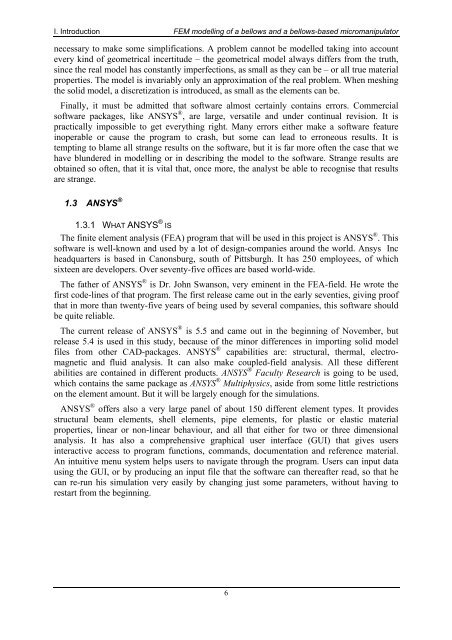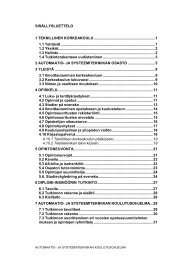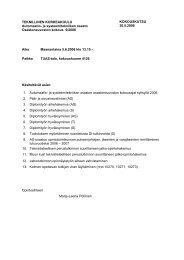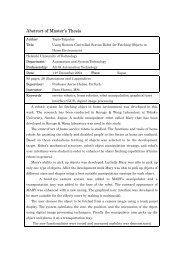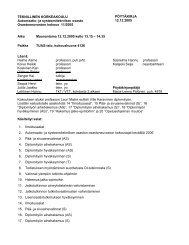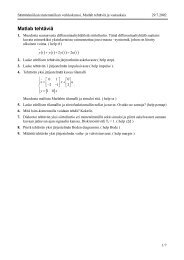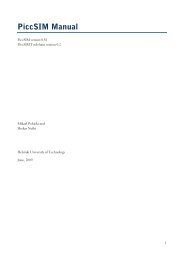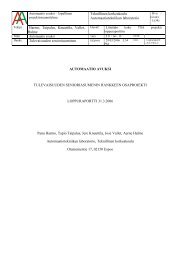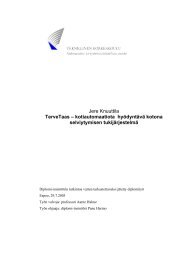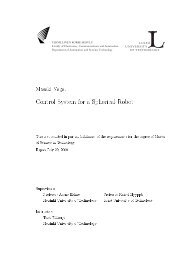fem modelling of a bellows and a bellows- based micromanipulator
fem modelling of a bellows and a bellows- based micromanipulator
fem modelling of a bellows and a bellows- based micromanipulator
You also want an ePaper? Increase the reach of your titles
YUMPU automatically turns print PDFs into web optimized ePapers that Google loves.
I. Introduction FEM <strong>modelling</strong> <strong>of</strong> a <strong>bellows</strong> <strong>and</strong> a <strong>bellows</strong>-<strong>based</strong> <strong>micromanipulator</strong>necessary to make some simplifications. A problem cannot be modelled taking into accountevery kind <strong>of</strong> geometrical incertitude – the geometrical model always differs from the truth,since the real model has constantly imperfections, as small as they can be – or all true materialproperties. The model is invariably only an approximation <strong>of</strong> the real problem. When meshingthe solid model, a discretization is introduced, as small as the elements can be.Finally, it must be admitted that s<strong>of</strong>tware almost certainly contains errors. Commercials<strong>of</strong>tware packages, like ANSYS ® , are large, versatile <strong>and</strong> under continual revision. It ispractically impossible to get everything right. Many errors either make a s<strong>of</strong>tware featureinoperable or cause the program to crash, but some can lead to erroneous results. It istempting to blame all strange results on the s<strong>of</strong>tware, but it is far more <strong>of</strong>ten the case that wehave blundered in <strong>modelling</strong> or in describing the model to the s<strong>of</strong>tware. Strange results areobtained so <strong>of</strong>ten, that it is vital that, once more, the analyst be able to recognise that resultsare strange.1.3 ANSYS ®1.3.1 WHAT ANSYS ® ISThe finite element analysis (FEA) program that will be used in this project is ANSYS ® . Thiss<strong>of</strong>tware is well-known <strong>and</strong> used by a lot <strong>of</strong> design-companies around the world. Ansys Incheadquarters is <strong>based</strong> in Canonsburg, south <strong>of</strong> Pittsburgh. It has 250 employees, <strong>of</strong> whichsixteen are developers. Over seventy-five <strong>of</strong>fices are <strong>based</strong> world-wide.The father <strong>of</strong> ANSYS ® is Dr. John Swanson, very eminent in the FEA-field. He wrote thefirst code-lines <strong>of</strong> that program. The first release came out in the early seventies, giving pro<strong>of</strong>that in more than twenty-five years <strong>of</strong> being used by several companies, this s<strong>of</strong>tware shouldbe quite reliable.The current release <strong>of</strong> ANSYS ® is 5.5 <strong>and</strong> came out in the beginning <strong>of</strong> November, butrelease 5.4 is used in this study, because <strong>of</strong> the minor differences in importing solid modelfiles from other CAD-packages. ANSYS ® capabilities are: structural, thermal, electromagnetic<strong>and</strong> fluid analysis. It can also make coupled-field analysis. All these differentabilities are contained in different products. ANSYS ® Faculty Research is going to be used,which contains the same package as ANSYS ® Multiphysics, aside from some little restrictionson the element amount. But it will be largely enough for the simulations.ANSYS ® <strong>of</strong>fers also a very large panel <strong>of</strong> about 150 different element types. It providesstructural beam elements, shell elements, pipe elements, for plastic or elastic materialproperties, linear or non-linear behaviour, <strong>and</strong> all that either for two or three dimensionalanalysis. It has also a comprehensive graphical user interface (GUI) that gives usersinteractive access to program functions, comm<strong>and</strong>s, documentation <strong>and</strong> reference material.An intuitive menu system helps users to navigate through the program. Users can input datausing the GUI, or by producing an input file that the s<strong>of</strong>tware can thereafter read, so that hecan re-run his simulation very easily by changing just some parameters, without having torestart from the beginning.6


